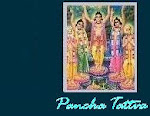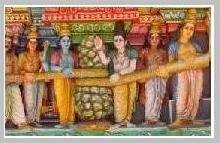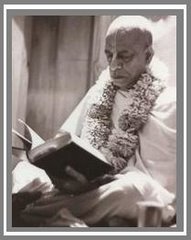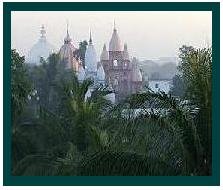
He first of all constructed a very strong wall covering ninety-six square miles, and the wall itself was within the sea. It was certainly wonderful and was planned and constructed by Visvakarma. No ordinary architect could construct such a fort within the sea, but an architect like Visvakarma, who is considered to be the engineer among the demigods, can execute such wonderful craftsmanship anywhere in any part of the universe. If huge planets can be floated in weightlessness in the outer space by the arrangement of the Supreme Personality of Godhead, surely the architectural construction of a fort within the sea covering a space of ninety-six square miles was not a very wonderful act.
It is stated in the Srimad-Bhagavatam that this new, well-constructed city, developed within the sea, had regular planned roads, streets and lanes. Not only were there well-planned roads, streets and lanes, but there were well-planned paths and gardens filled with plants known as kalpavrksas, or desire trees. These desire trees are not like the ordinary trees of the material world; the desire trees are found in the spiritual world. By Krsna's supreme will, everything is possible, so such desire trees were planted in the city of Dvaraka constructed by Krsna. The city was also filled with 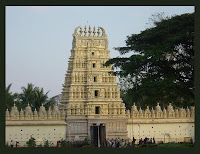 many palaces and planned and constructed by Visvakarma, or big gates. These gopuras are still found in some of the larger temples. They are very high and constructed with extreme artistic skill. Such palaces and gates held golden waterpots (kalasa). These waterpots on the gates or in the palaces are considered to be auspicious signs.
many palaces and planned and constructed by Visvakarma, or big gates. These gopuras are still found in some of the larger temples. They are very high and constructed with extreme artistic skill. Such palaces and gates held golden waterpots (kalasa). These waterpots on the gates or in the palaces are considered to be auspicious signs.
Almost all the palaces were skyscrapers. In each and every house there were big pots of gold and silver and grains stocked in underground rooms. And there were many golden waterpots within the rooms. The bedrooms were all bedecked with jewels, and the floors were mosaic pavements of marakata jewels.
The Visnu Deity, worshiped by the descendants of Yadu, was installed in each house in the city. The residential quarters were so arranged that the different castes, brahmanas, ksatriyas, vaisyas and sudras, had their respective quarters. It appears from this that the caste system was existing even at that time. In the center of the city there was another residential quarter made specifically for King Ugrasena. This place was the most dazzling of all the houses.
When the demigods saw that Krsna was constructing a particular city of His own choice, they sent the celebrated parijata flower of the heavenly planet to be planted in the new city, and they also sent a parliamentary house, Sudharma. The specific quality of this assembly house was that anyone participating in a meeting within it would overcome the influence of invalidity due to old age.
The demigod Varuna also presented a horse, which was all white except for black ears and which could run at the speed of the mind. Kuvera, the treasurer of the demigods, presented the art of attaining the eight perfectional stages of material opulences. In this way, all the demigods began to present their respective gifts according to their different capacities. There are thirty-three million demigods, and each of them is entrusted with a particular department of universal management. All the demigods took the opportunity of the Supreme Personality of Godhead's constructing a city of His own choice to present their respective gifts, making the city of Dvaraka unique within the universe. This proves that there are undoubtedly innumerable demigods, but none of them are independent of Krsna. As stated in the Caitanya-caritamrta, Krsna is the supreme master, and all others are servants. So all the servants took the opportunity of rendering service to Krsna when He was personally present within this universe. This example should be followed by all, especially those who are Krsna conscious, for they should serve Krsna by their respective abilities.
When the new city was fully constructed according to plan, Krsna transferred all the inhabitants of Mathura.
Krsna Book Ch-50 ----- ACBSP




